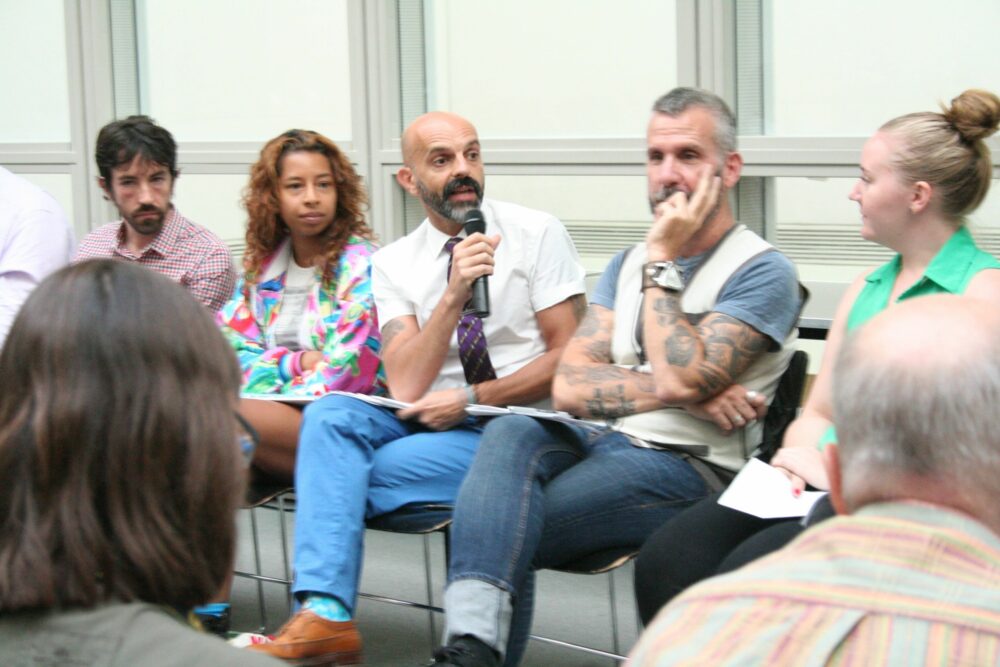On August 22, 2013, Visual AIDS along with the Pop Up Museum of Queer History and the Center for Lesbian and Gay Studies, held a public forum entitled, (re)Presenting AIDS: Culture and Accountability. The event was recorded and transcribed. Panelists we invited to present a short statement about their work related to AIDS, art, and representation. Below, Nelson Santos talks about Visual AIDS, and its role in the larger AIDS, art and representation conversation.
There are so many familiar faces here, that I kind of go into automatic mode and assume that everyone knows what Visual AIDS is, but just to back up a tiny bit –Visual AIDS was founded in 1988, this is our 25th anniversary, we are the oldest and the first organization to organize not just artists, but actually organize the arts community [museums, galleries, art institutes] to create action within the arts community. There was certainly artists, like, Gran Fury and other groups who were doing direct actions as artists and activist, but Visual AIDS was the first one who said, “What about the institutions? Why is MoMA not doing something? Why are these other organizations not doing something? Artists are dying left and right and they being ignored.” So props to Visual AIDS for being that organization who took the initiative to do that. And we continue to do arts projects, exhibitions, and assist artists living with HIV/AIDS while preserving a legacy for those artists who’ve passed away.
This summer we are presenting 3 exhibitions, including NOT OVER, curated by Kris [Nuzzi] and Sur [Rodney Sur]. I was excited about bringing these different individuals, different generations, different points of views together. We also presented a show at the [NYU] Fales Library that Andrew Blackley curated called Not only this, but ‘New language beckons us’ which also took historical works in the Fales Library's Downtown Collection–mostly by individuals who have passed away but also living artists, including Hunter Reynolds —and then had contemporary writers and artists respond to that work. Another show, at Printed Matter, titled House in Vermont–which abbreviations are H.I.V.– a term that some use as code, like “Oh, he has a house in Vermont...” [meaning he is HIV positive]. The artists prvtdncr and bodega vendetta took that term and presented a contemporary show at Printed Matter.
I mention those three show because I was excited to have all of these things going on at the same time and excited that all of those shows not only looked at parts of [HIV/AIDS] history but brought them to today. All of the shows had somebody responding today– making work today. It was about AIDS ongoing. And that’s something that I am proud about; being at an organization that has always tried to keep this in mind when we’re producing exhibitions.
So we were sitting around the Visual AIDS office and we were talking about all of the other [AIDS related] exhibitions. We were talking about the New York Historical Society exhibition [AIDS in New York: The First Five Years], the 1993 show at the New Museum [NYC 1993: Experimental Jet Set, Trash and No Star], I, You, We, at the Whitney, the Helen Molesworth's exhibition [This Will Have Been: Art, Love, and Politics in the 1980s], the ClampArt show NYC c. 1985, and Rosalind Solomon’s exhibition Portraits in the Time of AIDS, 1988, re-presented at Bruce Silverstein Gallery–and then, of course, all of the recent films [How to Survive a Plague, United in Anger: A History of ACT UP, We Were Here..]. So, there’s certainly something in the air, right? There is this looking back. None of those shows, in-and-of themselves are all wrong...and though I was excited to see many of these shows, it also frustrated me that they remain "historical.”
And so the discussion [to put this panel together] started with a desire to do more, to talk about responsibility. I want to thank Ted [Kerr] and Hugh [Ryan] for starting this spark and deciding “let's talk about this now.”
Download the full transcript at: (re)Presenting AIDS transcript
